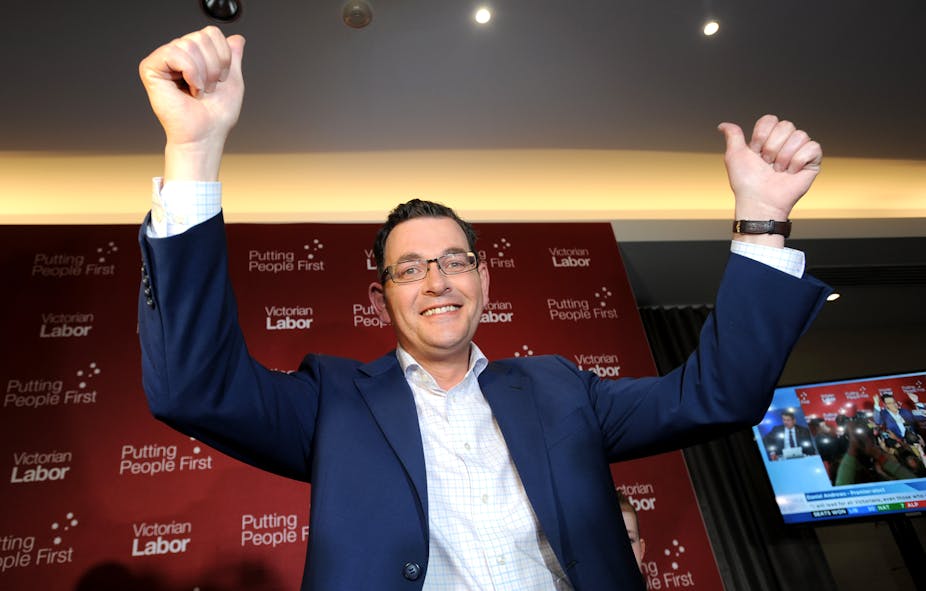With all election night votes counted, Labor has definitely won 44 of the 88 Victorian lower house seats, with the Coalition definitely winning 35 seats. The Nationals’ seat of Shepparton was lost to an independent, and eight seats are in at least some doubt. The vote count was only at 58.5%, with many more pre-poll, postal and absentee votes still to be added.
Of the seats that are currently doubtful, Carrum, Bentleigh and Frankston are all likely to be won by Labor, which would take its tally to 47. The Greens are likely to win Melbourne, which would be its first Victorian lower house seat. The Coalition is likely to win Morwell, South Barwon and Ripon. Prahran could be won by the Liberals, Labor or the Greens.
If we add the likely wins to the certain wins, Labor will have 47 seats (up seven), to 38 for the Coalition (down ten), one Green, one independent, and Prahran genuinely doubtful. The changes in seats reflect the post-redistribution 48-40 notional Coalition majority.
Labor’s primary vote was up 2.5% to 38.8%, while the Coalition’s combined primary vote was down 3.0% to 41.8%. The Greens vote was steady at 11.2%. These figures only reflect election night counting, and the Coalition and Greens will probably gain some ground at the expense of Labor in late counting.
The statewide two-party-preferred (2PP) vote will not be known for at least two weeks, but Labor probably won around 51.5% of the 2PP.
Labor won this election by holding their seats that had become notionally Coalition-held following a redistribution, and by apparently sweeping the “sandbelt” marginals of Carrum, Mordialloc, Bentleigh and Frankston. The only notional Coalition seat that the Coalition actually won was Ripon, where Labor was hurt by both an unfavourable redistribution and the retirement of a popular 15-year sitting member.
Early on election night, the Greens looked likely to win Richmond as well as Melbourne, and they seemed to have a good chance in Brunswick too. However, later returns favoured Labor in all three seats, and it has clearly held Richmond and Brunswick. While the Greens still lead in Melbourne, their margin has been reduced from earlier in the night.
This election was not a Labor landslide, but it is a clear win for Labor. The Coalition becomes the first one-term government in Victoria since the 1952-55 Labor government, and the first one-term government at any level in Australia since the 1996-98 Queensland Coalition government.
An assessment of pre-election polling will need to wait until all votes are counted and a 2PP known, but it is clear that the Coalition vote was a little higher than the 40% predicted by most final polls, and the Greens vote a little lower, while Labor’s vote was about right.
Ipsos had the Coalition vote about right at 42%, but overestimated Greens support and underestimated Labor. Morgan’s final poll had the Coalition on 44% to Labor’s 36%, which does not look good.
Senate-style chaos in upper house
In 2010, the Coalition won an upper house majority with 21 of the 40 seats to 16 for Labor and three Greens.
At this election, the ABC’s upper house calculator is currently giving the Coalition 16 seats (down five), Labor 13 seats (down three), the Greens five seats (up two) and “others” six seats. Only three of the eight regions will return just the three major players, while on current counting Northern Victoria will have two micro party representatives.
The “others” are currently projected to be three Shooters & Fishers, one Country Alliance, one Democratic Labour Party and one Sex Party. That means if Labor wants to pass legislation opposed by the Coalition, it will need the Greens and either the Shooters or the other three micro parties.
The reason why the major parties only appear to have won 29 of the 40 upper house seats is that their upper house vote was much lower than their lower house vote. Unfortunately, the Victorian Electoral Commission (VEC) is including informal votes in the percentage vote calculations, which means that the parties’ vote percentages are lower than they should be.
I have calculated the votes for both Houses in Excel. Where Labor received 38.8% in the lower house, its upper house vote was a paltry 33.7%. The Coalition’s upper house vote was 36.5%, compared with 41.8% in the lower house. Given this weak performance by the majors in the upper house combined with the group voting tickets, it is no surprise that micro parties were able to win many seats.

